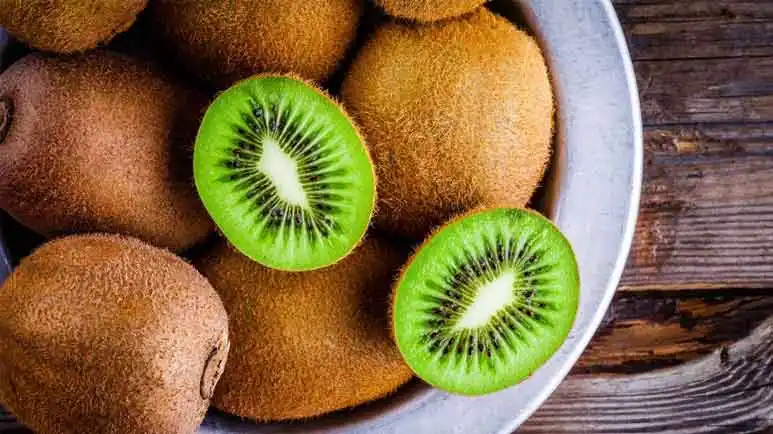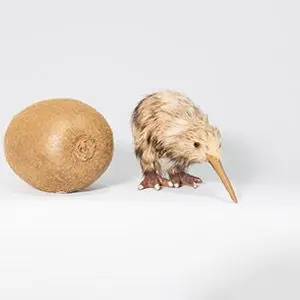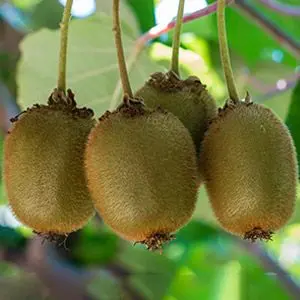Kiwifruit: The Fuzzy Fruit with a Secret Superpower
Packed full of nutrients like phytochemicals and vitamins C, K, and E, this brown, egg-shaped fruit offers more than meets the eye. Did you know it contains a special enzyme that may help with your pet's digestion, too?

STORY AT-A-GLANCE
- Kiwifruit is a significant source of phytochemicals, such as flavonoids, carotenoids and anthocyanins that are responsible for its rich pharmacological profile
- One standout nutrient in kiwi that may benefit your pet is actinidin, a predominant proteolytic enzyme that may help break down proteins and improve digestion
- Another potent phytochemical subcomponent in kiwifruit is lutein, a carotenoid that accumulates in the retina of the eye and may help reduce the risk of age-related blindness
- You can share small pieces of kiwi with your pets as occasional healthy treats, or add them to their species-appropriate, nutritionally adequate meals as food toppers
- When feeding kiwifruit to pets, slice it into small pieces to prevent choking, especially for larger breeds that might attempt to swallow it whole
Editor's Note: This article is a reprint. It was originally published May 18, 2023.
Kiwifruit’s (Actinidia deliciosa) brown, fuzzy, egg-shaped appearance doesn’t seem appealing at first, but once you slice it open and see the bright green flesh and black seeds inside, it’ll probably pique your curiosity. With a slightly acidic flavor reminiscent of a blend of banana, strawberry and pineapple, kiwifruit (usually shortened to “kiwi”), also known as Chinese gooseberry,1 is a versatile food that can be served in many ways, whether fresh (such as in salads) or added to cooked meals.
You might enjoy snacking on kiwi from time to time, but when your hungry pet decides they also want a bite, can you share it with them without worrying about any issues? Here’s what you should learn about feeding kiwifruit to your pets.
Did You Know?

While many people know these fruits simply as “kiwi,” the correct terminology is actually kiwifruit. This is because “kiwi” refers to a type of flightless bird that’s native to New Zealand and is distinguishable by its long, pointed beak and fuzzy brown skin. In fact, the fruit was named after the small bird due to their resemblance.2
New Zealand natives may also be offended if they overhear you using this name — in this country, kiwi is a nickname for their people, and they consider it a patriotic symbol of pride.3
What Is Kiwi, and Can Pets Eat It Safely?
Kiwifruit is an oval-shaped fruit that’s roughly the size of a chicken egg. The peel, which has a fuzzy texture, is edible, though it’s typically removed before eating. The flesh is commonly bright green, although some varieties have yellow flesh. Inside are rows of small black seeds, which are also edible.
When ripe, kiwi has a sweet flavor and is mildly acidic; its texture is similar to a ripe peach, though the seeds provide a bit of crunch in contrast to the smooth flesh.4,5
Kiwifruit is available year-round and is packed full of nutrients like vitamins C, K and E, as well as folate.6 It is safe to share with dogs and cats, as long as it’s prepared properly. You can share small pieces of kiwi with your pets as occasional healthy treats, or add them to their species-appropriate, nutritionally adequate meals as food toppers.
Phytochemicals Are Abundant in Kiwifruit
Kiwifruit is a significant source of phytochemicals, such as flavonoids, carotenoids and anthocyanins that are responsible for its rich pharmacological profile. This fruit also has gallic acid, caffeic acid, syringic acid, ferulic acid and salicylic acid, which may provide various pharmacological properties, including antitumor, antidiabetic, anti-inflammatory and antioxidant effects.7
For example, a study found that gallic acid (GA) may help boost immune and antioxidant activities in stressed puppies by alleviating gut dysfunction. According to the researchers, “Dietary supplementation of GA alleviates oxidative stress and inflammatory response in stressed puppies by causing beneficial shifts on gut microbiota and metabolites that may support gut and host health.”8 Meanwhile, mice studies found that caffeic and ferulic acids have brain iron-chelating properties that may help prevent neurogenic diseases.9
Another potent phytochemical subcomponent in kiwifruit is lutein, a carotenoid that accumulates in the retina of the eye and may help reduce the risk of age-related blindness.10 However, its benefits go beyond eye health — one study in sled dogs found that supplementation of antioxidants, including 20 milligrams of lutein orally per day for a month, helped attenuate exercise-induced oxidative damage.11
Catechins are another phytochemical found in kiwifruit and other foods like green tea, which may have protective properties against cancer.12 In animal models, catechins were found to have a protective role against degenerative diseases.13
Kiwifruit May Help with Digestion
One standout nutrient in kiwi that may benefit your pet is actinidin. This predominant proteolytic enzyme may help break down proteins and improve digestion. Just like the enzymes bromelain in pineapples and papain in papaya, actinidin works by helping dissolve proteins, allowing your pet’s meals to pass smoothly through their digestive system.14,15 One study conducted on mice subjects supported this claim, noting:16
“[D]ietary actinidin enhanced the gastric digestion of some food proteins. We studied the impact of dietary kiwifruit on the digestion of food proteins. Green kiwifruit increased the gastric digestion of muscle, gelatin, SPI [soy protein isolate] and gluten.”
Protein-assimilating nutrients like this may be ideal for senior pets, as they need more protein but may have difficulty digesting it. For example, about 20% of cats 14 years and up don’t digest protein efficiently, which may cause them to lose both fat and muscle mass. Adding foods like kiwifruit to their diet may be a good move to help keep their digestion functioning optimally, if your cat shows an interest in them.
Kiwifruit Trivia

Kiwifruits take a bit longer to grow compared to other fruits, needing more than 200 days without frost in order to reach maturity. Even a few days of frost can ruin these plants, so farmers need to be especially vigilant in protecting their crops from cold weather.17
Other Antioxidants in Kiwifruit
Vitamin C is one antioxidant that you’ll find in abundance in kiwi. In fact, this fruit has three times more vitamin C compared to oranges and strawberries based on an edible flesh weight basis.18 Although pets can synthesize their own vitamin in their body, getting extra amounts from external sources may be ideal, especially since this nutrient helps reduce inflammation, scavenge harmful free radicals and slow down cognitive aging.19
Another potent antioxidant abundant in kiwifruit is vitamin E, which may help keep your pet’s heart, liver, muscles, immune system and skin healthy. It may also help ease inflammation associated with canine osteoarthritis.20 According to an article in the Innovative Veterinary Care Journal, “Higher doses of vitamin E may reduce inflammatory markers and histological expression as well as improve signs of pain.”21
Kiwi Production in the US

Kiwi is not a cold-hardy crop,22 which is why the majority of kiwifruit in the country is grown in the state of California. Some hardy varieties are also grown in the Pacific Northwest.23

How to Feed Kiwifruit to Your Pets
Misinformation about healthy fruits, vegetables, nuts and seeds is all over the internet, mostly because websites have labeled all risks (such as the risk of overconsumption causing gastrointestinal issues, or choking on too large of pieces or pits) as "toxicities." Not all of these are true yet they’ve managed to confuse millions of pet lovers, nonetheless.
In the case of kiwifruit, the common warning is to avoid feeding the whole fruit to pets, especially to large breeds like golden retrievers. This is because big dogs may devour the fruit whole, and it could get lodged in their throat, causing a choking hazard. Remember, when feeding kiwifruit to pets, always slice it in small pieces and only give in small amounts. Kiwi also contains sugar, so giving small amounts means you’re not overloading them with sugar, which could be problematic.
You can give kiwifruit as training treats, placing them inside training toys for your pets to play with, or mash them up and spread on their lick mat. Just remember that these treats should only make up 10% of your pet’s daily caloric intake. To add texture to your pet’s homemade meals, you can also slice a few pieces and put them on your pet’s food as a topper.
Kiwifruit Sustainability
A study that looked at the eco-efficiency of kiwifruit production in New Zealand found that kiwifruit orchards that follow organic practices were more eco-efficient compared to integrated orchards. They noted:24
“We defined eco-efficiency on an area basis as NZD net profit per kg greenhouse gas emissions (1 NZD = 0.83 USD, 31/10/2013). Carbon footprints for the cultivars and management systems were comparable …
Our analysis revealed fertilizer use and the N-associated emissions as hot spots for greenhouse gas emissions. Opportunities to reduce greenhouse gas emissions arise in the background system of fertilizer production, packaging, storage and transport, and the optimization of nutrient-use efficiency in the orchard.”
Although kiwifruit is not included in the Environmental Working Group’s (EWG) Dirty Dozen list, it’s best to purchase organic, spray-free varieties from your local farmers market, whenever possible, to make sure you avoid exposing yourself and your family (pets included) to unwanted toxic pesticides.
Sources and References
- 1 Britannica, Kiwi
- 2,17 10 Facts About, Ten Fun Facts About Kiwi Fruits (Archived)
- 3 Gardening Channel, Kiwi vs. Kiwifruit, Explained
- 4 The Spruce Eats, February 15, 2023 (Archived)
- 5 WebMD, September 9, 2022
- 6 The Spruce Pets, August 10, 2023
- 7 Journal of Food Processing and Preservation, Volume 45, Issue 6, June 2021
- 8 Front Immunol. 2022 Jan 14:12:813890
- 9 Front Neurol. 2022 Oct 14;13:951725
- 10,12,15 Rashtriya Krishi, Volume 10, Issue 2, December 2015
- 11 Am J Vet Res. 2000 Aug;61(8):886-91
- 13 The Journal of NutritionVolume 134, Issue 12, December 2004, Pages 3431S-3440S
- 14 Phytochemistry. 2012 May:77:46-52
- 16 Food Chemistry, December 2011, 129 (4):1681-1689
- 18 Eur J Nutr. 2018 Feb 22;57(8):2659–2676
- 19 American Kennel Club, May 14, 2024
- 20 Can J Vet Res. 2013 Jul;77(3):191-8
- 21 IVC Journal, February 10, 2017 (Archived)
- 22 The Ohio State University, May 28, 2020
- 23 AgriFarming, How to Grow Kiwi in USA: A Farming and Production Guide to Planting to Harvesting for Beginners
- 24 Journal of Cleaner Production, Volume 106, 1 November 2015, Pages 333-342











